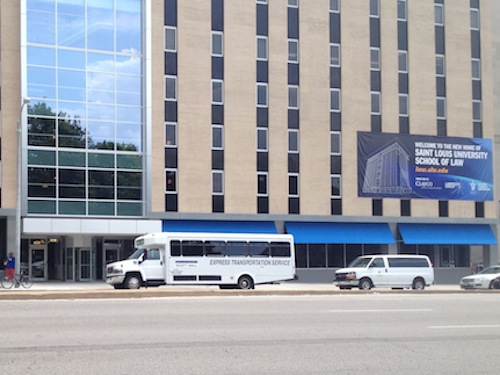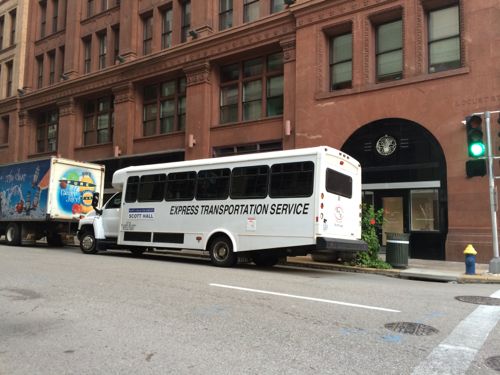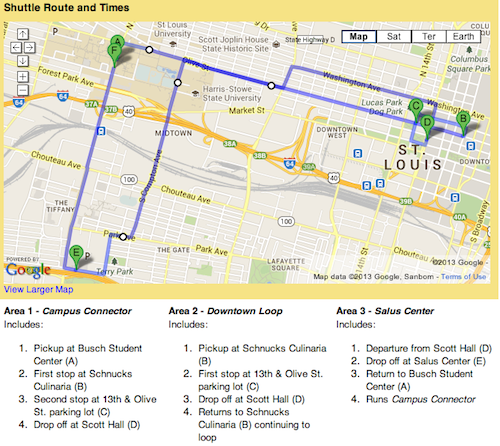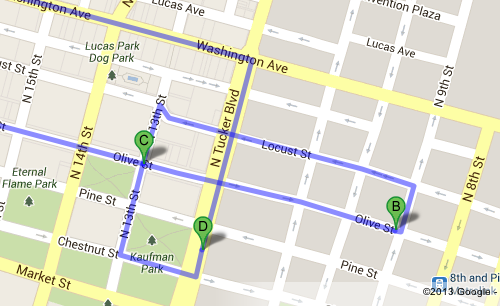Saint Louis University Law School Shuttle
One reason for trying to build the St. Louis Streetcar is to reduce the number of polluting buses on the streets, in particular, from shuttles for the new Saint Louis University School of Law (my review of the building). The law school is open and the diesel-powered shuttles are very visible.


Here’s a quick summary of the route:
Scott Hall Shuttle You can access Scott Hall from the main university and designated law school parking via a new shuttle. Hours and information can be found here. The shuttle will connect Scott Hall to the main University campus, Salus Center and the law school parking at Schnucks Culnaria and 1215 Olive St. surface lot. The final shuttle runs from Scott Hall at 10:10 p.m. with drop-offs at Culinaria, the 1215 parking lot and finally at Busch Student Center. (source)
And here’s visuals:


Seems excessive too me, especially when they sit and idle, spewing diesel fumes. Guess law students won’t mix with the general public with such an elaborate shuttle system at their disposal. Presumably, though, amy SLU faculty, staff, or student, can ride it.
— Steve Patterson
One bus trip replaces multiple car trips. Both types of vehicles pollute – what is the NET impact? Metro is subsidized by the taxpayers, this isn’t (no problem for me, as a taxpayer). Streetcars are NOT non-polluting – electricity, around here, comes from either burning coal or nuclear power plants. A remote pollution source may help downtown, but it’s no ecological asset to whatever rural area where it’s located. And finally, it’s not about “not mixing with the general public”, it’s about meeting a specific need, to get between specific points as quickly as possible on a schedule that is compatible with the students’ class schedules!
Yes, generating the electricity to power streetcars does pollute. But the carbon footprint per person is less than running multiple buses (Metro, SLU, etc)
That assumes that SLU students would even ride Metro if their shuttle were not provided. If they choose to drive, their per person carbon footprint spikes significantly, compared to running parallel bus routes.
Remember, these are two different constituencies and two different markets. In your fantasy world, SLU students would be hopping on and off transit to visit small neighborhood businesses along the route. In reality, SLU students will primarily patronize businesses within walking distance of their origin and/or destination. In contrast, Metro does provide service, albeit more slowly, for those riders whose origin or destination is not a SLU facility (and there’s nothing to prevent SLU students from using Metro).
I’m guessing that this service is being operated under contract with a private company, and that its use will be evaluated and tweaked as time goes on. The current routing and the current stops were created in a vacuum, based on assumptions on where demand might be. The reality likely is somewhat different, and I’d expect changes to be made at the end of the year (and that’s the beauty of a bus over a streetcar – you don’t need to be 100% right, right from the start).
maybe they would use metro if students had a metro pass LIKE EVERY OTHER COLLEGE IN THE METRO AREA
Agreed, SLU doesn’t even make it possible for students to buy semester passes! http://www.metrostlouis.org/FaresPasses/Studentsemesterpasses.aspx
SLU made a business decision to fund parking lots and parking structures instead of spending money subsidizing Metro UPasses for their students. The question is why? Do more SLU students want to drive than students at “every other college in the metro area”? Or, is parking an assumption / core principal of the administration and their plans for their campus(es)? Are SLU students expressing any interest in getting Metro passes? Or, are they fine with their current transportation options? Just because you/I/we think that SLU students want more public transit options does not mean that the students, themselves, want more options! (And to clarify, a full-time student at ANY college can buy a semester pass, only 4 local colleges / universities offer subsidized UPasses – see Steve’s link.)
Yeah, because the schools that do offer passes don’t have any parking lots… oh wait
As a student at the law school, I can confirm that many of my classmates would prefer having subsidized Metro Passes, but instead we are stuck with parking that costs $1200 per school year and is five blocks from the school. I think that SLU Law could benefit from doing away with the shuttle system (it’s never available when it’s needed and isn’t worth the cost and pollution) and work on providing better public transit options for the students.
Much ado about nothing.
Everything is relative.
If this excessive why isn’t 6 miles of street car that follows the same path and parallels the existing Metrolink? Buying a shuttle, paying a driver and operating probably cost less than the $200k feasibility study for the $218M streetcar. This a first step to build the demand that may require a street car down the road.
A Monday-Friday SLU-only shuttle system doesn’t build demand for anything more.
I hear no astonishment at the loss of a few hundred people from the heart of midtown and the effect on those businesses. Like pollution, this is just shifting from point A to point B. And there are clean-air busses that can be alternates to “reduce the number of polluting buses on the streets”.
This is either another attempted slam at SLU or a ‘grasping at straws’ to gain support for trolley or both.
The previous SLU law school didn’t appear to have an impact on the surroundings, so the loss should be minimal. Nadoz might feel the loss though.
Didn’t appear? so you don’t really know. There are plenty of businesses surrounding SLU that the loss of 2-300 people daily will impact. But their loss is ok so that downtown gains a few more customers? And now it’s about how those customers get delivered. How is this different than the 2 North County cities fighting over Walmart? It’s just shifting the problem.
If “pollution” were an issue at all, where is the outrage at all the busses that Wash U runs around their campuses…some cutting right through a park no less. They run longer and some even run on the weekends and nights. SLU has what….1 or 2 busses to make this loop and 1, maybe 3 to circle the main campus/health center, but Wash U has what? 30? 40? at least! And who has the more parking lots? Talk about polluting!!!
You’re right, I don’t know. To really know any negative impact on midtown by the relocation of the law school downtown would’ve required a study beforehand to determine which businesses, if any, law faculty, staff, & students patronized on a regular basis. To my knowledge nobody had done such a study and it’s too late now. In a few years someone could do a study to look at sales tax receipts before and after the move, adjusting for other factors, to draw a conclusion.
A few years ago I had one law class, I found the law school to be very internally focused. With a cafe on the main floor there was little reason to even cross Lindell to go to Nadoz. Joe Boccardi’s & Chuey’s both failed in the lower level of the Coronado despite being across the street from the law school.
Again, I don’t think the old law school had much of an impact on the surroundings, not like it’ll have downtown.
Hopefully we can all agree that idling is a needless waste. It’s like littering but with pollution rather than garbage.
Exactly! If I lived in the school board apts I’d be furious if I couldn’t open my windows on nice days.
Idling is limited to five minutes: http://www.cleanair-stlouis.com/casl/index.html . . the trick now becomes one of enforcement, especially on hot or cold days, when the vehicle is left idling to keep the operator and passengers comfortable.
^ thanks for the link. I didn’t see anything about allowing idling for 5 minutes. The voluntary program suggests turning off vehicles when not in use except when there is extreme cold or heat, etc.
This shuttle runs so infrequently to the Main Campus that its impact on anything is minimal to reduce driving. Once every two hours. The Downtown circulation to the parking garages isn’t easily duplicated by Metro, but the runs to the Main and HSC campus are, and run much more frequently than this shuttle does. Replacing the runs to Main campus with Metro ride ons would be very helpful to those wanting to use it.
My law school had the same thing, a shuttle from the undergrad campus to the law school downtown, taking maybe 45 minutes. I never used it, even though it was free to me, and used bus or subway as needed.
I’m not sure how much the law students will need it, since law students tend to be pretty separate from undergrads. The professors will probably all drive (or maybe bike or walk) rather than use any kind of bus. But sometimes students might need access to the university generally, especially for nightlife and for university events. It makes it easier for them to live in midtown but go to school downtown. I figure it’s better to have too much transportation downtown rather than too little. Especially if it pulls together two active parts of the city – midtown and downtown. It also makes sense for SLU to do what it can to mitigate the separation of its campuses.